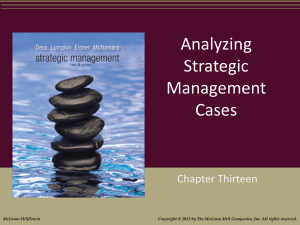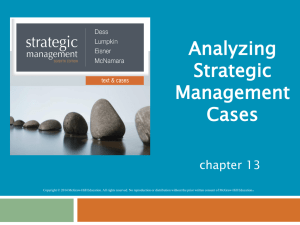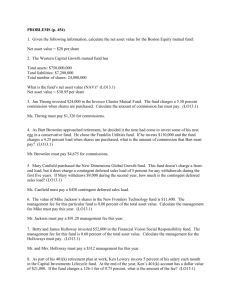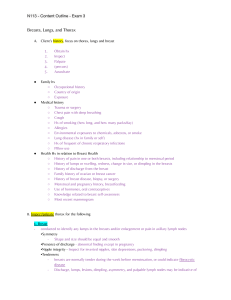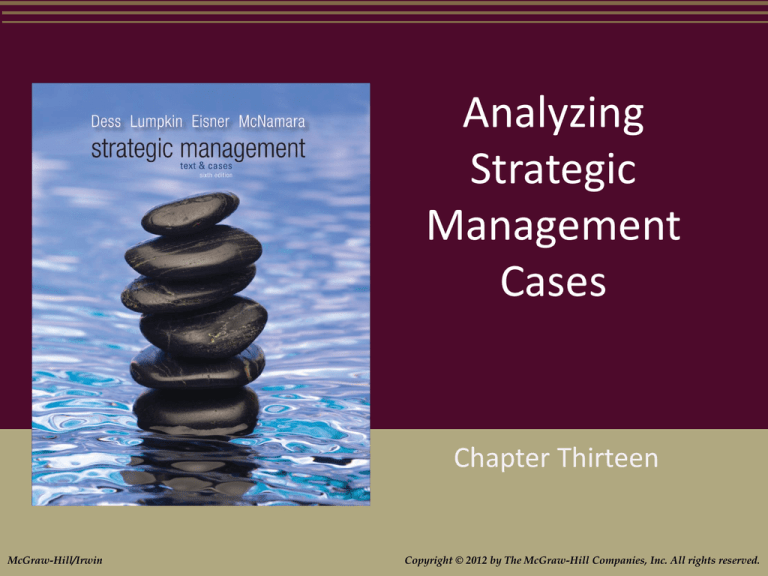
Analyzing
Strategic
Management
Cases
Chapter Thirteen
McGraw-Hill/Irwin
Copyright © 2012 by The McGraw-Hill Companies, Inc. All rights reserved.
Learning Objectives
After reading this chapter, you should have a
good understanding of:
LO13.1 How strategic case analysis is used to
simulate real-world experiences.
LO13.2 How analyzing strategic management cases
can help develop the ability to differentiate,
speculate, and integrate when evaluating
complex business problems.
LO13.3 The steps involved in conducting a strategic
management case analysis.
13-2
Learning Objectives (cont.)
LO13.4 How to get the most out of case analysis.
LO13.5 How conflict-inducing discussion
techniques can lead to better decisions.
LO13.6 How to use the strategic insights and
material from each of the 12 previous
chapters in the text to analyze issues posed
by strategic management cases.
13-3
Questions Raised
Why do some firms succeed and others fail?
Why are some companies higher performers
than others?
What information is needed in the strategic
planning process?
How do competing values and beliefs affect
strategic decision making?
What skills and capabilities are needed to
implement a strategy effectively?
13-4
Why Analyze Strategic
Management Cases?
Case analysis
A method of learning complex strategic
management concepts
places students in the middle of an
actual situation and challenges them to
figure out what
to do.
13-5
How to Conduct a Case Analysis
Step 1: Become familiar with the material
Read quickly through the case one time
Use initial read-through to assess
possible links to strategic concepts
Read the case again, making notes
13-6
How to Conduct a Case Analysis
Step 1: Become familiar with the material
Evaluate how strategic concepts might
inform key decisions or suggest
alternative solutions.
After forming first recommendation,
thumb through the case again to
assess consequences of actions you
propose
13-7
How to Conduct a Case Analysis
Step 2: Identify problems
Some cases have more than one
problem
Avoid getting hung up on symptoms
Articulate the problem
Some problems are not apparent until
after you do the analysis
13-8
How to Conduct a Case Analysis
Step 3: Conduct strategic analyses
Determine which strategic issues are
involved
Use strategic tools to conduct the
analysis
Test your own assumptions about the
case
13-9
Tools to Conduct Analysis
Five forces
Contingency
analysis
Value-chain
analysis
frameworks
Financial ratio
analysis
13-10
Financial Ratio Analysis
Financial ratio analysis
Method of evaluating a company’s
performance and financial wellbeing
through ratios of accounting values,
including short-term solvency, longterm solvency, asset utilization,
profitability, and market value ratios.
13-11
How to Conduct a Case Analysis
Step 4: Propose
alternative solutions
Develop a list of
options first without
judging them
Evaluate
alternatives
13-12
How to Conduct a Case Analysis
Step 5: Make recommendations
Make a set of recommendations that
your analysis supports
Describe exactly what needs to be
done
Explain why this course of action will
solve the problem
Include suggestions for how best to
implement the proposed solution
13-13
Preparing an Oral Case Presentation
Organize your thoughts
Emphasize strategic analysis
Be logical and consistent
Defend your position
Share presentation responsibilities
13-14
Preparing a Written Case Analysis
Exhibit 13.3
13-15

